Caring For and Charging Your Leisure Battery
It's a fact that few batteries die a natural death. Most are impacted by owners that cycle them too deeply, let them sit discharged for too long, or store them at a temperature that is too high.
In this guide to caring for and charging your leisure battery, we look at what you can do to protect your investment against premature failure.
Written By Terry Owen
Years of Battery Power
With care, a lead acid battery can last for seven years or more. Without care, it could be dead inside one. Perhaps the biggest single cause of premature failure is leaving a battery in a partial, or complete, state of discharge for more than a few days.
As you discharge a lead-acid battery, lead sulphate forms on the plates. During recharge, the sulphate converts back to lead and lead dioxide. However, if left for an extended period, the sulphate crystallises, making it difficult to change back. The process is known as sulphation and can significantly reduce the performance of the battery.
Over the years, various remedies and chargers have appeared that claim to reverse the effects of sulphation but, in the author's experience, it's much better to avoid it in the first place.
Buying Your Perfect Caravan, the 2024 special edition is available now. Including everything you need to know about buying your first caravan, with essential guides, top tips and buying advice. Available in both digital and print. Find out more about either the digital edition here or the Print edition here.
Over-Discharging the Battery
The second leading cause of premature failure is over discharging. The deeper you discharge a lead-acid battery, the shorter its life will be. A budget leisure battery that in reality is little different from a car battery may suffer damage if discharged below 80% of its capacity – see 'lead-shedding'.
A good quality, flooded leisure battery, will tolerate discharge down to 50% on a regular basis, as many as 200 times. AGM and gel types can nearly double this, although care needs to be taken when charging gel batteries if damage is to be avoided - see panel.
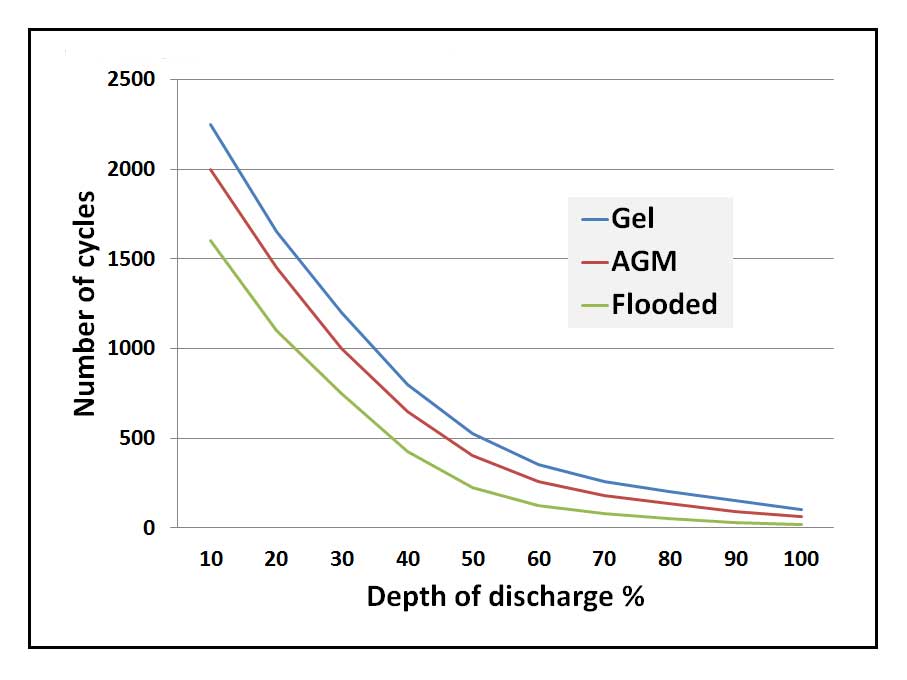
Typical performance curves for good quality leisure batteries in a caring regime
The voltage of a battery at rest, and without load, is an indication of its state of charge. The following table shows the approximate state of charge of a lead acid battery under these conditions. If you aim to stop the voltage going below 12.20 volts on a regular basis, this will greatly help battery life. This voltage equates to about 50% charge with a flooded battery, and 40% with AGM and gel types.
|
Approximate state of charge |
Sealed or flooded lead acid battery voltage |
AGM & spiral wound battery voltage |
Gel battery voltage |
|---|---|---|---|
| 100% | 12.70+ | 12.80+ | 12.85+ |
| 75% | 12.4 | 12.6 | 12.65 |
| 50% | 12.2 | 12.3 | 12.35 |
| 40% | 12.1 | 12.2 | 12.2 |
| 25% | 12 | 12 | 12 |
| 0% | 11.8 | 11.8 | 11.8 |
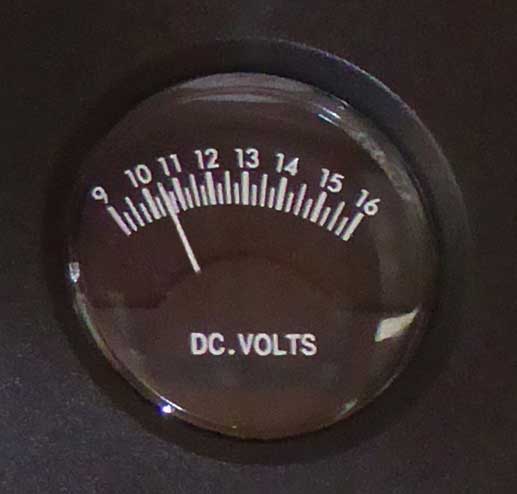
A caravan battery this flat is only fit for recycling
Get Caravan magazine from just £19.99

Caravan magazine has been inspiring caravanners for more than 80 years! Every monthly issue is packed with caravan travel inspiration, the best sites to stay on, caravan road tests, reviews and buying guides, plus top technical advice.
Caravan’s fully searchable digital library gives you access to the latest issues, plus every edition of Caravan since February 2013.
Topping up
Flooded leisure batteries may require topping up from time to time as the level of electrolytes fall because the battery converts water content into hydrogen and oxygen. For this purpose, you must only use distilled, or de-ionised water should. Tap water contains minerals that may reduce a battery's capacity and increase its self-discharge rate.
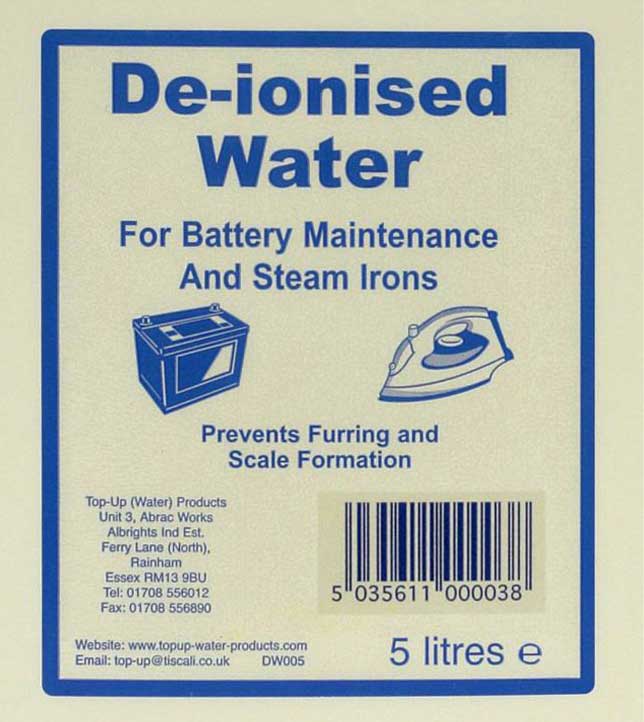
Only use de-ionise or distilled water for topping up
Don't allow the tops of the plates to become dry; this will cause damage. When low, add only enough water to cover the exposed plates before charging. Always fill to the correct level after you have finished charging your battery. On no account should sulphuric acid be used for topping up, as this will upset the battery's chemistry and accelerate corrosion.
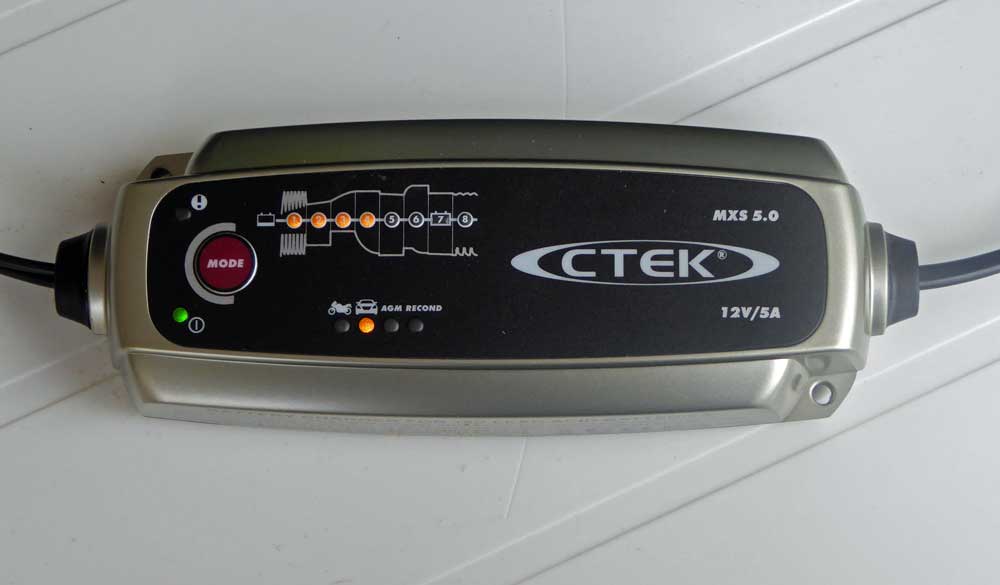
A multi-stage charger in action
Charging the leisure battery
The primary function of a caravan's power supply is to provide 12-volt power, and not to charge the leisure battery. Many are designed to work at a constant voltage of 13.6, to 13.8 volts. This level is carefully chosen to prevent gassing and possible damage to the battery through overcharging. However, it is not enough to give the battery a full charge. For this, the voltage needs to rise to 14.4 volts for a period, before dropping back.
In recent years, some caravan manufacturers have been fitting 'intelligent', multi-stage, power supply/chargers. During stage one, the battery voltage is increased gradually while the current is limited to start the charging process and protect the battery.
At stage two, the voltage rises to 14.4 volts to deliver the bulk charge to the battery. When you've charged your battery, the voltage is decreased at stage three to 13.6 volts, to provide a float charge to maintain the battery in the fully charged state, while preventing damage through overcharging.
If a load, such as a water pump switches on, the charger senses it and increases the voltage back to 14.4 volts to keep the battery topped up. Such chargers can be left on continuously and will take pretty good care of your battery.
Your handbook should give details if you have one.
Where caravans have a constant voltage power supply, rather than an intelligent charger, it's a good idea to remove the battery occasionally and to charge it with a multi-stage charger, such as one such as those manufactured by CTEK. These can be left connected indefinitely without fear of any damage.
Charging gel batteries
You can easily damage gel batteries through overcharging, so it's important to check that any charger you may wish to use is suitable for use with the size of battery you have. As a general rule, the charging current should not exceed 0.2C, where 'C' is the amp-hour capacity of the battery. Once charged, it's important to drop the voltage back to about 13.6 volts to avoid damage.
Charging issues are one reason why AGM batteries have, on the whole, superseded gel batteries in many applications. These have most of the advantages of gel, with none of the disadvantages.
Lead shedding
One of the factors that can reduce the life of a battery is 'lead shedding'. This action is where particles of lead fall off the plates during use. You often see the phenomenon on the lead oxide paste applied to the positive plates of the battery. It's a natural occurrence that you can't avoid, but it can be reduced by avoiding deep cycling and overcharging.
Overcharging can occur if you charge a battery too quickly, or if the float voltage at the end of the charge exceeds 13.8 volts for an extended period. If you do so, it can lead to gassing which, in time, can cause the lead paste to fall off.
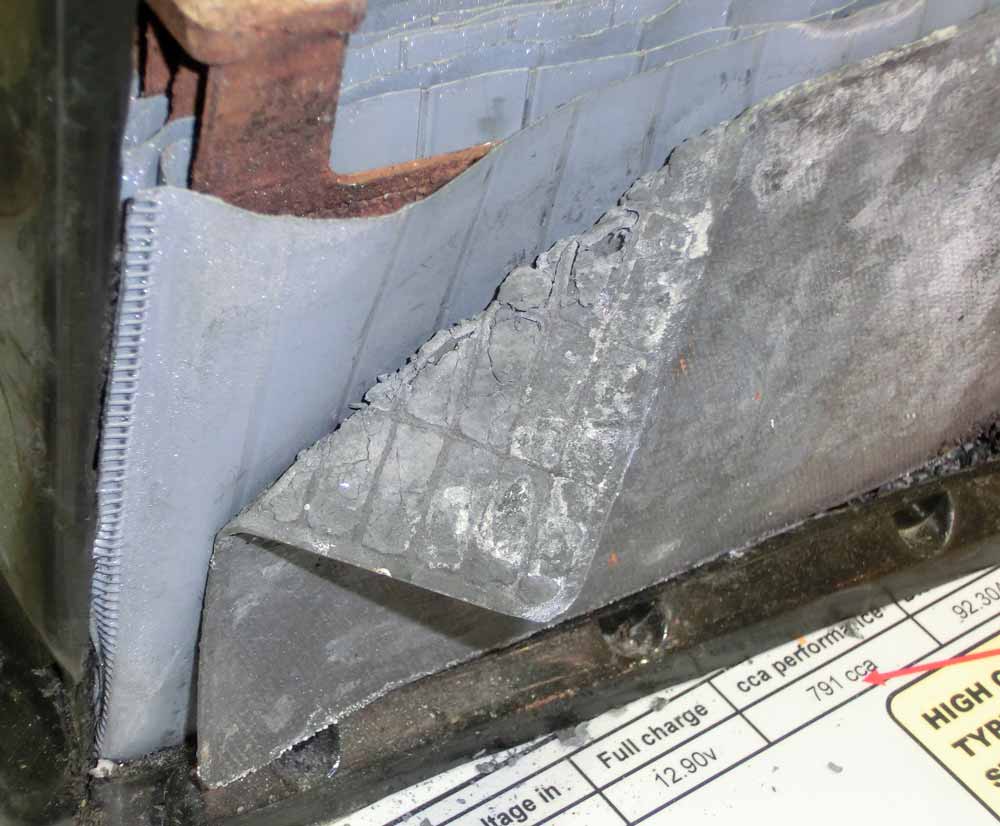
The poor state of the plates on this battery shows why it failed
As you might expect, losing material from the plates reduces the capacity of the battery, but another problem is that the material can build up at the bottom of the battery shorting the plates together. These so-called 'soft shorts' are difficult to detect, as the battery behaves normally after a charge.
At this stage, the only clue might be a warming of the battery. However, after resting for 24 hours, the battery's open circuit voltage will be reduced, as the short will have consumed some of the battery's energy.
By the nature of their construction, AGM and gel batteries have a much better resistance to lead shedding than flooded types. It's also worth noting that flooded batteries designed for leisure use should contain glass fibre sheets pressing against the lead oxide paste. These help to hold it in place during deep cycling.
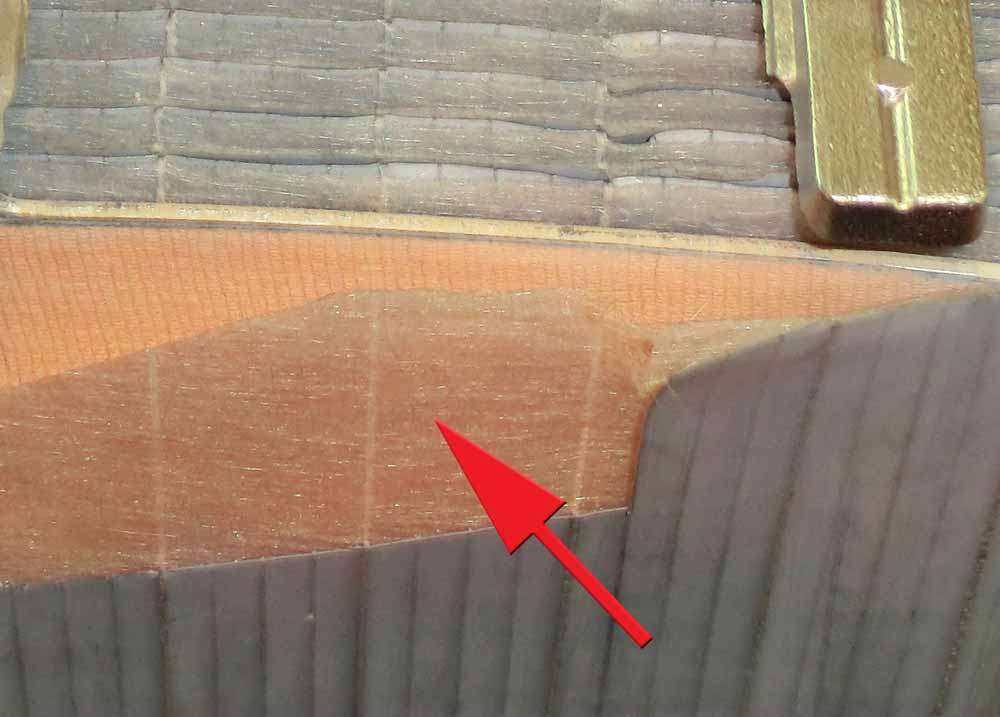
This glass fibre sheet contributes to holding the lead paste onto the plates during deep cycling
Self-discharge
All batteries slowly discharge, even when not connected to anything. With lead acid batteries, the rate of discharge depends on the ambient temperature and the type of construction. At a temperature of 25 degrees Celsius, flooded batteries self-discharge at about nine percent per month, whereas AGM and gel types come in at around three percent. At 10 degrees Celsius these figures are more than halved so that maintenance charges can be less frequent during the winter months.
Buying Your Perfect Caravan 2024

Looking for more great caravan buying information? You need the brand-new guide to Buying Your Perfect Caravan, it’s packed with everything you need to help you with choosing, buying, owning and enjoying your very first caravan.
Learn more about it here.
Digital edition
Download it now from Pocketmags for just £9.99
Print edition
Or order a printed edition for just £9.99 + P&P
Expert Caravan advice to your door!

Caravan magazine has been inspiring caravanners for more than 80 years! We have grown to become a leading authority on caravans, the caravan industry, caravan lifestyle, campsites and caravan travel destinations. We know what our readers want – and that's to make the most of their caravans and their holidays!
Want to know more about Caravan magazine?
About Caravan magazine







Recent Updates
Caravan showers: all you need to know
In this guide, we’ll discuss the different types of showers, how they work, and how to fit an external shower point to your caravan ...
Caravan towing: all you need to know
Towing a caravan may seem daunting initially, but a few simple tips can make the journey enjoyable and ...
All you need to know about towbars & towballs
Flange, detachable, swan neck, retractable – towbar technology choice is bewildering. Don’t worry. We’ll ...
Caravan WiFi: everything you need to know
Caravan holidays are the ultimate way of getting away from it all, although we sometimes need a link to the ...
Caravan insurance: all you need to know
Navigating the world of caravan insurance can feel like a daunting task. Fear not, as this comprehensive ...
Buying a caravan: what you need to know
Let us guide you through some of the complicated things to think about when first looking at buying a ...
Caravan awnings: a buyers' guide
Caravan awnings are a fantastic addition to any caravan as they are one of the simplest, quickest and most ...
Caravan electrics: avoid tripping out
All caravan owners have overloaded their mains supply at some time. Here’s how to master caravan electrics ...
Caravan heating systems: a quick guide to caravanning warmth
When winter is here, you’ll be glad of a decent caravan heating system if you’re out touring. Here’s how the ...
Caravan damp: a complete guide
There's little more guaranteed to strike fear into the heart of a caravan owner than the word 'damp'. But if ...
Other Articles
Caravan jockey wheels: the definitive guide
A well-functioning caravan jockey wheel can make all the difference to manoeuvring away from the towcar, especially if you don't have a caravan mover ...
Caravan cooking recipes
Caravan cookery inspirational ideas. No need to stress out in the kitchen with these quick and easy ...
Caravan bike racks: a complete guide
Exploring the beautiful surroundings while on a caravan trip is undeniably one of the greatest joys of the ...
Caravan solar panels: all you need to know
Whether you dream of roaming off-grid or just fancy reducing your carbon footprint, fitting solar panels to ...
The ultimate guide to caravan layouts
Choosing the right layout or floorplan of your caravan is an all-important part of the buying process – find ...
A guide to seasonal caravan pitches
Our in-depth guide to finding and securing seasonal caravan pitches on your favourite campsite ...
Caravan weights and payloads: a quick guide
The terminology of caravan weight – MIRO, MTPLM, noseweight, kerbweight, payload, weight plate upgrade – is ...
The ultimate guide to caravan motor movers
Caravan motor movers: everything you need to know about remote control caravan manoeuvring ...
Caravan cleaning: All you need to know
Whether you’re taking the caravan out for the first time or it’s just in need of a spruce up, our guide will ...
18 essential items for camping with your dog
Camping is for the whole family – including our four-legged members. Here's what you'll need to keep your dog ...